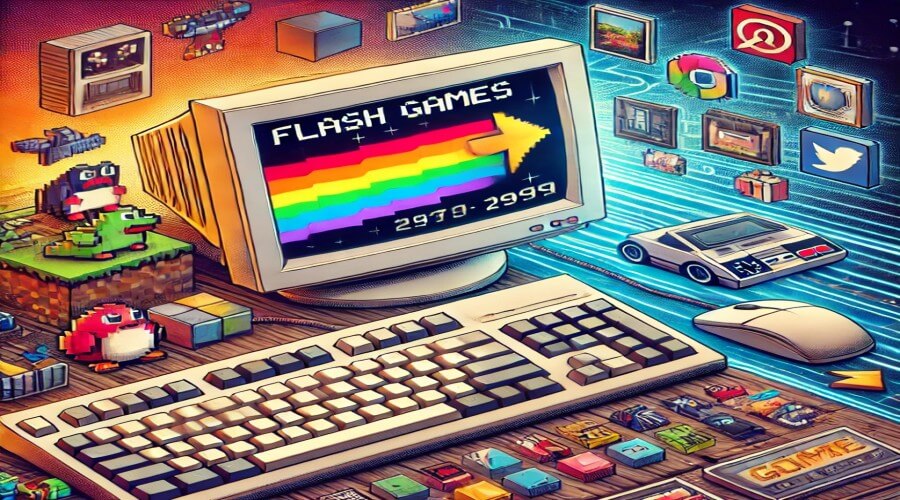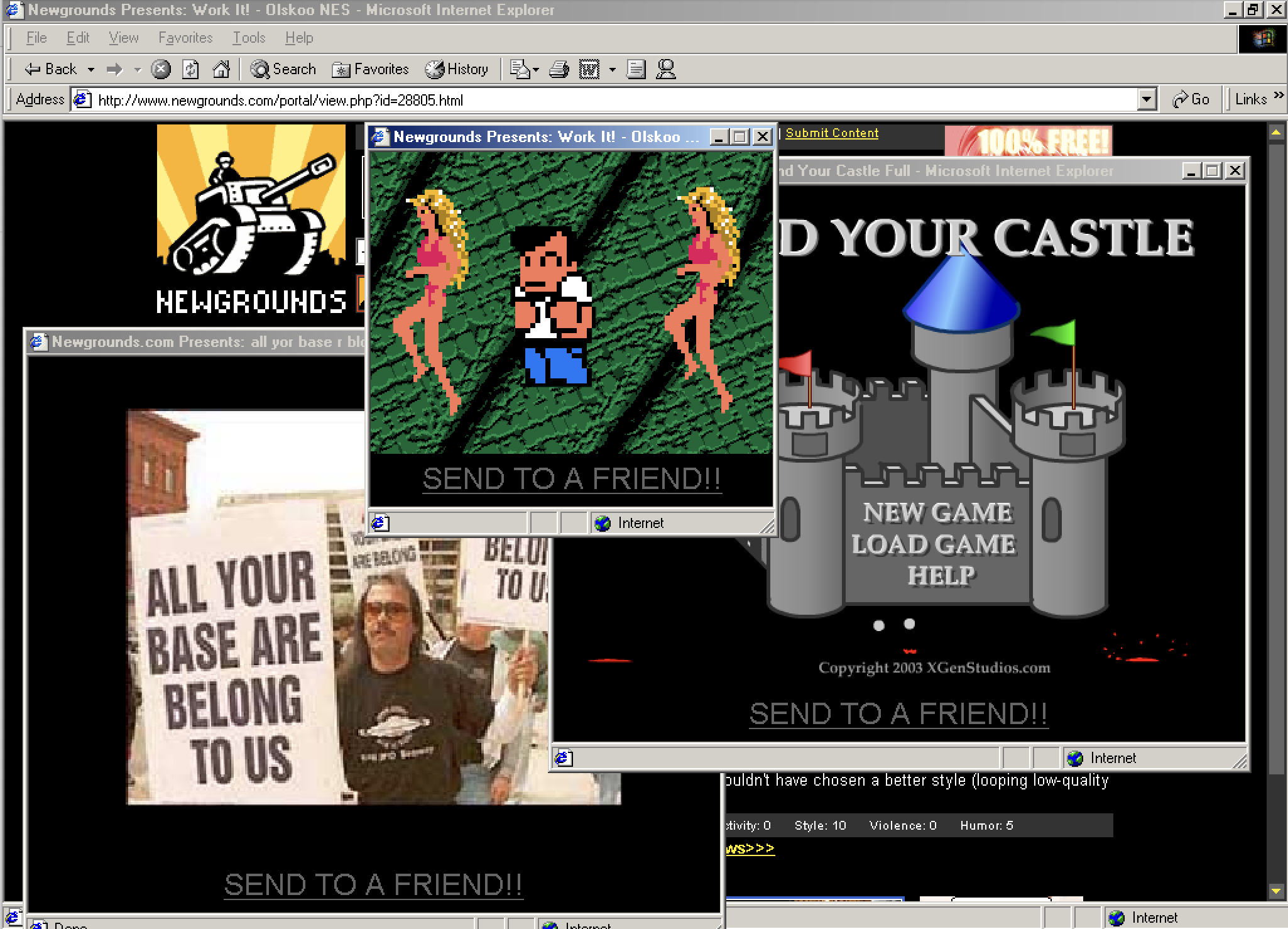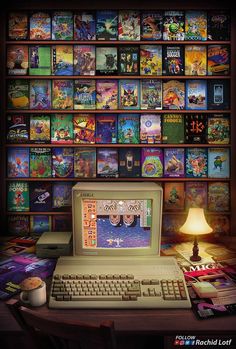
Travel back to the internet of the late 90s and early 2000s—a time before app stores ruled our phones and before Steam reshaped PC gaming. Back then, the web browser was home to a unique digital playground. This era marked the golden age in the Complete History of Flash Games, when simple, addictive titles captivated millions and defined a generation of online entertainment.
Powered by Macromedia (later Adobe) Flash technology, millions discovered a universe of interactive entertainment on websites like Newgrounds, Miniclip, Armor Games, and Kongregate.
From simple animations and physics puzzles to complex strategy games and bizarre experimental creations, Flash democratized game development and consumption [Google Search]. It fueled internet culture, launched indie developer careers, and provided countless hours of procrastination for students and office workers alike [Google Search].
Though the technology itself has faded, the legacy of Flash gaming – its creativity, accessibility, and impact – remains profound. Let’s hit play on the history of this pivotal era in browser gaming.
The Dawn of Interactive Web: Flash Arrives

The story of Flash games begins with the technology itself. Originally developed as a vector animation tool called SmartSketch by Jonathan Gay’s FutureWave Software in the mid-90s, it quickly evolved [Google Search]. Recognizing the potential for web animation, the software became FutureSplash Animator [Google Search]. Its ability to create scalable vector graphics with small file sizes made it ideal for the bandwidth-constrained early web [Google Search].
Macromedia acquired FutureSplash in 1996 and rebranded it as Flash [Google Search]. Key developments fueled its rise:
- Vector Graphics: Unlike pixel-based bitmap graphics, Flash’s vector graphics could scale to any size without losing quality or significantly increasing file size – perfect for varying screen resolutions [Google Search].
- ActionScript: The introduction and evolution of ActionScript, an object-oriented scripting language, allowed developers to add complex interactivity, moving beyond simple animations to create actual games [Google Search].
- Accessibility: The Flash Player plugin became ubiquitous, installed on the vast majority of web browsers. This meant Flash content could reach a huge audience without complex installation processes [Google Search]. Content ran (mostly) the same way on any platform [Google Search].
- Ease of Development (Relatively): While requiring skill, the Flash authoring environment provided an integrated toolset for graphics, animation, and coding, lowering the barrier to entry compared to traditional game development [Google Search].
This combination of factors created fertile ground for a new wave of creativity. Hobbyists, students, and small studios could suddenly create and distribute interactive experiences to a massive audience directly through the web browser.
The Evolution of Browser Playgrounds: Flash Game Mania

The late 90s saw the first experiments, but the early to mid-2000s were the true explosion years for Flash gaming.
- Pioneering Portals: Websites emerged specifically to host and categorize this burgeoning content.
- Newgrounds (Founded 1995, Flash Portal late 90s/early 00s): Founded by Tom Fulp, Newgrounds became a legendary hub for user-generated Flash games and animations, known for its open submission policy (“Everything, By Everyone”) and often edgy or experimental content. Games like Fulp’s own Pico’s School pushed the boundaries of early Flash capabilities [Google Search].
- Miniclip (Founded 2001): Focused on high-quality, often licensed or original Flash games with broad appeal.
- Armor Games (Founded 2004): Known for curating high-quality RPGs, strategy, and adventure Flash games.
- Kongregate (Founded 2006): Integrated social features, achievements, and chat alongside a massive library of games.
- AddictingGames (Acquired by Atom Entertainment 2000s): As the name suggests, focused on quick, addictive gameplay loops.
- Viral Hits & Emerging Genres: Simple, shareable games spread like wildfire via email and links. Early hits often relied on basic physics, humor, or simple skill challenges. Genres popularized or defined by Flash include:
- Launch Games: (e.g., Kitten Cannon) – Propelling objects for maximum distance/destruction.
- Physics Puzzlers: (e.g., Line Rider, Fantastic Contraption) – Creative problem-solving with physics engines.
- Tower Defense: Flash versions of Warcraft III mods like Element TD popularized the genre online, leading to hits like Kingdom Rush [Google Search].
- Escape the Room: Point-and-click puzzle games with intricate scenarios.
- Platformers: Many innovative platformers emerged, known for tight controls and creative level design (e.g., N, Meat Boy – precursor to Super Meat Boy).
- Dress-Up Games: A huge genre appealing to a different demographic, allowing avatar customization [Google Search].
- Endless Runners: Games like Canabalt (2009) helped popularize this genre on the web before it exploded on mobile [Google Search].
- Indie Springboard: Flash became a crucial platform for independent developers. Creators like Edmund McMillen (Meat Boy), The Behemoth (Alien Hominid, originally a Flash game), and countless others honed their skills and built audiences through Flash portals before moving to console or PC releases [Google Search].
This era was characterized by incredible creativity, diversity, and accessibility. Anyone with a browser and the Flash plugin could access thousands of free games, fostering a unique online gaming culture.
“Technical” Specs: Flash vs. The Rest

How did Flash games stack up against other forms of web and casual gaming technology at the time and later?
| Feature | Early Web Games (Java Applets, DHTML ~Mid-90s) | Flash Games (Peak Era ~2000s) | HTML5 Games (~2010s onwards) | Native Mobile Games (~2010s onwards) |
| Technology | Java Virtual Machine, JavaScript/HTML | Flash Player Plugin (SWF files) | HTML5, CSS3, JavaScript | Native Code (iOS/Android SDKs) |
| Graphics | Basic 2D, Limited Animation | Vector Graphics, 2D Animation | Canvas/WebGL, CSS Animations | 2D/3D, Hardware Accelerated |
| Performance | Often Slow, High CPU Usage | Variable, ActionScript limits | Generally Good, Improving | Optimized for Device Hardware |
| Accessibility | Required Java Plugin (Often slow/buggy) | Required Flash Plugin (Ubiquitous) | Native Browser Support | Requires App Store Download/Install |
| Development | Complex (Java), Limited (DHTML) | Integrated IDE (Flash Pro), ActionScript | Standard Web Tools, JS Frameworks | Native SDKs, Engines (Unity, Unreal) |
| Platform Reach | Desktop Browsers (Declined rapidly) | Desktop Browsers (Massive reach) | Modern Browsers (Desktop/Mobile) | Specific Mobile OS (iOS/Android) |
| Security | Java Sandbox (Some issues) | Numerous Major Vulnerabilities | Standard Web Security Model | App Store Review, OS Sandboxing |
| Monetization | Rarely Monetized | Ad-supported Portals, Sponsorships | Ads, In-App Purchases (Web) | In-App Purchases, Ads, Premium |
Export to Sheets
Flash offered a unique sweet spot for its time: significantly more powerful and easier to develop for than earlier web technologies, and vastly more accessible than downloadable native games, thanks to the near-universal Flash plugin. Its downfall came as its weaknesses (security, performance, lack of mobile support) were surpassed by newer, native web technologies (HTML5) and the explosion of dedicated mobile gaming platforms.
Cultural Impact: Memes, Indies, and Internet History

The Flash era wasn’t just about games; it fundamentally shaped internet culture and the trajectory of independent game development.
- Democratization of Game Creation: Flash lowered the barrier to entry, allowing solo developers and small teams to create and distribute games globally without needing publishers or complex distribution deals [Google Search]. This fostered immense creativity and experimentation.
- Birthplace of Indie Stars: Many successful indie developers got their start making Flash games, learning design, building communities, and even prototyping ideas that later became successful commercial releases (e.g., Super Meat Boy, The Binding of Isaac, Alien Hominid) [Google Search].
- Fueling Internet Culture: Flash animations and games were central to early internet humor and meme culture. Sites like Newgrounds hosted countless viral animations (like “Badger Badger Badger” or “The End of the World”) and games that became shared cultural touchstones [Google Search].
- Defining Web Aesthetics: The distinct vector art style, tweened animations, and even the specific quirks of Flash became a recognizable aesthetic of the 2000s internet [Google Search]. Author Lev Manovich argued Flash aesthetics exemplified “the cultural sensibility of a new generation” [Google Search].
- New Genres and Mechanics: Flash developers experimented constantly, popularizing genres like tower defense and endless runners, and iterating on countless unique gameplay mechanics [Google Search].
- Casual Gaming Boom: Flash portals made gaming accessible and acceptable to a much broader audience, paving the way for the casual gaming explosion on social media and mobile devices.
Flash games were more than just disposable entertainment; they were a vital ecosystem for creativity, community, and cultural expression in the formative years of the mainstream internet.
Collector’s Corner: Saving the SWF Files – Flash Preservation

With Adobe officially ending support for Flash Player on December 31, 2020, and browsers removing the plugin, accessing this vast library of games and animations became impossible through normal means. This spurred significant preservation efforts.
- The End of an Era: Adobe’s decision, driven by security concerns, performance issues, and the rise of HTML5 and mobile platforms (accelerated by Apple’s refusal to support Flash on iOS), marked the official end of Flash’s dominance.
- Flashpoint Archive: This is the most significant Flash preservation project. Started by BlueMaxima and now a massive community effort, Flashpoint has archived hundreds of thousands of Flash games and animations (as well as content from other defunct web plugins) [Google Search].
- It uses a combination of a launcher application and specialized server software (acting locally) to allow these games to run offline in a secure environment, tricking them into thinking they are still online if necessary [Google Search]. They offer different versions: “Infinity” downloads games on demand, while “Ultimate” contains the entire massive archive for offline use [Google Search].
- Ruffle Emulator: Ruffle is an open-source Flash Player emulator written in the Rust programming language [Google Search]. It aims to run SWF content safely within modern browsers (using WebAssembly) or as a desktop application. The Internet Archive uses Ruffle to allow users to play many archived Flash games directly in their browser via the Wayback Machine [Google Search].
- Internet Archive: Beyond using Ruffle, the Internet Archive itself has archived countless websites that hosted Flash games, preserving the context in which they were played.
- Challenges: Preservation faces challenges including the sheer volume of content, broken links, games requiring specific server interactions that are hard to replicate, and potential copyright issues [Google Search].
Collecting Flash games today primarily means supporting and utilizing these preservation projects, ensuring this vital part of digital heritage isn’t lost.
Why We Miss the Flash Era’s Flicker

Why the deep nostalgia for Flash games, often technologically simple and sometimes frustrating?
- Unfettered Creativity: The low barrier to entry and lack of gatekeeping by platforms or publishers meant Flash was a wild garden of creativity. Games could be deeply personal, experimental, strange, or subversive in ways often missing from polished commercial releases [Google Search].
- Accessibility and Immediacy: Click a link, wait a moment for the loading bar, and play. There were no complex installs, launchers, or app stores. Gaming felt instantly accessible to anyone with a browser.
- Sense of Discovery: Browse portals like Newgrounds or Kongregate felt like digging for treasure. You could stumble upon unexpected gems, innovative mechanics, or hilarious animations shared simply for the love of creation [Google Search].
- Shared Experience: Despite being mostly single-player, Flash gaming felt communal. Sharing links, competing for high scores on portals, and discussing viral hits created a shared online culture around these games [Google Search].
- Simplicity: Many Flash games focused on one core mechanic executed well. They offered satisfying gameplay loops without the complex systems, tutorials, and monetization schemes common today [Google Search].
- The “Free” Factor: The vast majority of Flash games were free to play, supported by portal ads or developer passion, creating a massive library of entertainment available to everyone.
We don’t miss the security holes, the slow loading times on dial-up, or the sometimes-buggy performance. But we miss the spirit of the Flash era: its boundless creativity, its accessibility, its sense of community, and the feeling that anyone could make and share something interactive with the world.
Beyond the End-of-Life: Flash’s Lasting Impact

Though the Flash Player plugin is gone from our browsers, the impact of the Flash game era continues to ripple through the gaming landscape and internet culture. It was a crucial incubator for indie talent, providing a platform for developers who would go on to create beloved modern classics [Google Search]. It normalized browser-based gaming, paving the way for HTML5 and WebGL experiences. It fostered vibrant online communities built around creation and sharing [Google Search].
The quirky aesthetics, innovative mechanics, and sheer volume of creativity unleashed during Flash’s golden age represent a unique and irreplaceable part of digital heritage [Google Search]. Thanks to dedicated preservation efforts like Flashpoint and Ruffle, future generations can still experience the games that defined browser-based entertainment for over a decade [Google Search]. The loading bars may be gone, but the legacy of Flash gaming continues to play on.






